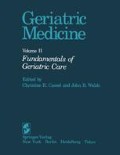Abstract
All available medical evidence shows that functional capacity at the cellular, tissue, organ, and system levels decreases with age. The most important losses in the cardiovascular system are related to heart function. The ability of the heart to pump blood (maximum cardiac output) declines approximately 8% per decade after adulthood.1 Blood pressure typically increases with age as fatty deposits gradually clog the coronary arteries and the circulation decreases.
Access this chapter
Tax calculation will be finalised at checkout
Purchases are for personal use only
References
Julius S, Amery A, Whitlock LS, et al: Influence of age on the hemodynamic response to exercise. Circulation36: 222 – 230, 1967.
Robinson S: Experimental studies of physical fitness in relation to age. Arbeitsphysiologie10: 251 – 353, 1938.
Astrand I: Aerobic work capacity in men and women with special reference to age. Acta Physiol Scand, 49 (suppl 169): 1 – 92, 1960.
Saltin B, Blomquist G, Mitchell JH, et al: Response to Exercise After Bed Rest and After Training. AHA Monograph No 23. New York, The American Heart Association, 1968.
Adams GM, de Vries HA: Physiological effects of an exercise training regimen upon women aged 52–79. J Gerontol28: 50 – 55, 1973.
Chapman EA, de Vries HA, Swezey R: Joint stiffness: Effects of exercise on young and old men. J Gerontol27: 218 – 221, 1972.
de Vries HA: Physiological effects of an exercise training regimen upon men aged 52–88. J Gerontol25: 325 – 336, 1970.
de Vries HA: Prescription of exercise for older men from telemetered exercise stress data. Geriatrics26: 102 – 111, Apr 1971.
de Vries HA: Exercise intensity threshold for improvement of cardiovascular-respiratory function in older men. Geriatrics 26: 91 – 101, Apr 1971.
de Vries HA: Physiology of Exercise. Dubuque, Iowa, William C Brown Co, 1974.
de Vries HA, Adams GM: Comparison of exercise responses in old and young men: The cardiac effort total body effort relationship. J Gerontol27: 344 – 348, 1972.
de Vries HA, Adams GM: Comparison of exercise responses in old and young men: II. Ventilatory mechanics. J Gerontol27: 349 – 352, 1972.
de Vries HA, Adams GM: Electromyographic comparison of single doses of exercise and meprobamate as to effects on muscular relaxation. Am J Physiol51: 130 – 141, 1972.
de Vries HA, Adams GM: Muscle mass vs relative loading of individual muscles as determinants of exercise response in older men. Med Sci Sports 4: 146 – 154, 1972.
de Vries HA, Adams GM: Effect of the type of exercise upon the work of the heart in older men. J Sports Med Phys Fitness17: 41 – 47, 1977.
Tuttle WW, Horvath SM: Comparison of effects of static and dynamic work on blood pressure and heart rate. J Appl Physiol10: 294 – 296, 1957.
Asmussen E, Hemmingsen I: Determination of maximum working capacity at different ages in work with the legs or with the arms. Scand J Clin Lab Invest10: 67 – 71, 1958.
Astrand PO, Ekblom B, Messin R, et al: Intraarterial blood pressure during exercise with different muscle groups. J Appl Physiol20: 253 – 256, 1965.
Bevegard S, Freyschuss U, Strandell T: Circulatory adaptation to arm and leg exercise in supine and sitting position. J Appl Physiol21: 37 – 46, 1966.
Astrand I, Guharay A, Wahren J: Circulatory response to arm exercise with different arm positions. J Appl Physiol25: 528 – 532, 1968.
Lind AR, McNicol GW: Circulatory responses to sustained handgrip contractions performed during other exercise, both rhythmic and static. J Physiol192: 595 – 607, 1967.
Lind AR, McNicol GW: Muscular factors which determine the cardiovascular responses to sustained and rhythmic exercise. Can Med Assoc J96: 706 – 713, 1967.
Lind AR, McNicol GW: Cardiovascular responses to holding and carrying weights by hand and by shoulder harness. J Appl Physiol 25: 261 – 267, 1968.
Editor information
Editors and Affiliations
Rights and permissions
Copyright information
© 1984 Springer-Verlag New York, Inc.
About this chapter
Cite this chapter
De Vries, H.A. (1984). Exercise. In: Cassel, C.K., Walsh, J.R. (eds) Geriatric Medicine. Springer, New York, NY. https://doi.org/10.1007/978-1-4612-5232-0_13
Download citation
DOI: https://doi.org/10.1007/978-1-4612-5232-0_13
Publisher Name: Springer, New York, NY
Print ISBN: 978-1-4612-9749-9
Online ISBN: 978-1-4612-5232-0
eBook Packages: Springer Book Archive

